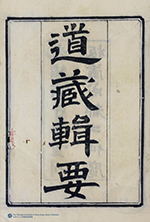《道藏輯要・提要》 黎志添主編
*即時訂購可享8折優惠,詳情請致電3943 4464或電郵至daoist@cuhk.edu.hk查詢
<< 訂購表格 >>
《道藏輯要》是繼明《正統道藏》(1445)之後一部最重要的道教叢書。眾所周知,《正統道藏》收集了明代正統年間之前的道教經典,之後的《萬曆續道藏》(1607)又補修了一些新出道書。相較而言,《道藏輯要》則是近代道教經典收藏量最大的選集,除了明《道藏》中的經典之外,其中也收錄有不少藏外道書,既包括明之前已出而《道藏》未收的道經,也有明清之際新出的道書。因此,它無疑是明清時期最有價值的道教經典選本,同時也是研究明清道教不可或缺的資料來源。
《道藏輯要》共二十八卷,以二十八星宿依次命名,所收文本門類眾多,包括內丹學、宇宙學、哲學、儀式戒律,還有儒、道兩家經典、地方志、碑銘等等,不一而足。
《道藏輯要》為蔣予蒲(字元庭,1755-1819)於清嘉慶年間(1796-1820)所編輯並刻板印刷(其中增收藏外道經91部),是所有流通本的底本。雖然這些嘉慶本很難見到,但所幸的是在中國大陸、臺灣、日本和歐洲的一些圖書館裡還有收藏,如四川省圖書館、日本京都大學人文科學研究所、東京大學、東洋文庫、巴黎法蘭西學院高等漢學研究所等機構,共計17種版本。它們也是最知名的光緒《重刊道藏輯要》(1906)所依據的底本。由賀龍驤與彭瀚然編纂出版於四川成都二仙庵的重刊版本(又增收道經19部),在近年也經過了多家出版社的不斷重印,如臺灣的考正、新文豐出版社於20世紀70年代分別重印。巴蜀出版社重印於1985年,之後又於1995年出版縮印本。儘管頻頻重印,然而無論是中國的學者,還是日本或歐美的學者,對現存版本(蔣元庭的《道藏輯要》與賀龍驤的《重刊道藏輯要》)的形成基礎卻鮮有認真而深入的分析。
《道藏輯要・提要》出版計劃原先由意大利道教學者莫尼卡(Monica Esposito)教授主持,2011年莫氏逝世後,改由香港中文大學道教文化研究中心黎志添教授主持,在中文大學道教文化研究中心執行,由臺灣蔣經國基金會、日本學術振興會和香港蓬瀛仙館等機構贊助。參與《道藏輯要・提要》出版計劃的學者共計70多位,包括日本、歐美、中國大陸、臺灣、香港等地的道教研究者。
《道藏輯要・提要》旨在為《道藏輯要》(包括《重刊道藏輯要》)所收明《正統道藏》及其補編本《萬曆續道藏》的藏內道經及未收錄於其中的藏外道經和註本,提供詳實且條理清晰的信息,不僅包括經文的文本歷史和版本來源,還將更多介紹經文的基本內容。每篇提要的內容包括:
| 1. | 篇首提示:列舉經文的題目、長度(卷數)、作者及其在《重刊道藏輯要》中的位置 |
| 2. | 一般信息:經文題目釋義、編著者簡介、序跋題署等信息、經文內容簡介、經文同其他文獻和傳統之間的關係 |
| 3. | 經文章節概要:關鍵段落、術語的解釋與討論 |
| 4. | 經文出處及版本列舉 |
| 5. | 參考文獻 |
《道藏輯要》經多次、多地、不同背景道教人士的重印,再加上其與明清之際漸盛的呂祖信仰、道教乩壇及全真教之間的複雜聯繫,它所承載的意義不僅僅停留於道教典籍收集本身,更是展現整個清代道教,尤其是清代各地呂祖道壇及全真道教的發展情況。
《道藏輯要》的編輯過程不僅涉及明清文人階層、呂祖乩壇、扶乩信仰、全真教、內丹修煉團體等不同社會階層、團體的參與者,其經典出處又廣及北京、湖北、河南、山東、江蘇、浙江、四川等地,因此我們堅信其研究成果對於明清文史研究領域,包括社會史、刻書史、地方史、文獻學等,也定將有所裨益。除此之外,《道藏輯要》收錄了大量的內丹修煉文獻,對於中國內丹、養生文化、科學技術史等有興趣的讀者和研究者,都可以參考此部研究文集,不僅可以在修煉術語上有所獲得,還可以在不同派別的內丹修煉術及其歷史發展、經典等方面,得到更多啟發。
綜上所述,基於《道藏輯要》的豐富內容與編撰歷史,無論是專業領域的道教研究者、中國宗教史研究者、歷史學者及相關學術研究機構,或是出自個人興趣而希望在道教內丹、養生等方面有所精進的普通讀者或團體,《道藏輯要・提要》都可以作為一部極具參考價值的案頭書。
作為首部有關《道藏輯要》的解題編著,《道藏輯要・提要》既是一部高質量的研究文集,同時也具有一定的工具書性質,其單篇形式的研究成果將為研究某一特定經典或主題的道教研究者提供便利。而對於整部《道藏輯要》及其編撰背景,即明清道教發展史的考量,又將引導道教研究者立足於一個更具全局性的高度。由此,對於中國宗教史研究者而言,這也將是有關中華帝國晚期宗教史研究的一部必不可少的參考書。
Publication Preview: Companion to the Essentials of the Daoist Canon
Edited by Lai Chi Tim
The Daozang Jiyao 道藏輯要 [the Essentials of the Daoist Canon] is the fundamental Daoist anthology of the Qing dynasty (1644-1912), which has been the object of an international research project since 2006, involving a team of 70 highly qualified Daoist scholars from various institutions all over the world. The results of this research –The Companion to the Essentials of the Daoist Canon, will be presented in the form of 307 articles compiled into a three-volume work, is going to be published in the year 2021.
The Companion to the Essentials of the Daoist Canon, as the title of this collection suggests is considered to represent the quintessence of the Ming Daoist Canon (Zhengtong Daozang 正統道藏) of 1445. On closer examination, only about 60% of the texts are from the Ming dynasty Canon and other texts are new materials added by the editors of the Qing. The texts coming from other sources which can be classified as “extra-canonical texts” thus amount to about one third of the collection. With more than three hundred texts, it is by far the largest Daoist anthology of the Qing period. The contents cover a wide range of topics from commentaries to Daoist and Neo-Confucian classics, inner alchemy, litanies, monastic and lay liturgy, moral instructions, epigraphy and much else. In spite of its importance no companion has yet been produced.
The whole complexity of the textual tradition of this Canon came gradually to light through bibliographical research done by Monica Esposito, Lai Chi Tim, and other project members. According to this research, and the analysis of 16 printed copies of rare editions of the Daozang Jiyao extant in various libraries around the world (China, Taiwan, Japan, France), it is now established with certainty, the existence of only two basic editions: 1) the Daozang Jiyao of the Jiaqing 嘉慶 (1796-1820) edition (or known as “old Daozang Jiyao”); 2) the Reprint of the Daozang Jiyao 重刊道藏輯要 Erxian’an (二仙庵) edition of 1906 (or “new Daozang Jiyao”), simply abbreviated as “Chongkan”. Thanks to the discovery of rare editions of this last Daoist Canon, which are preserved in Chinese, Taiwanese, Japanese, and European libraries, it has become possible to reconstruct the history of the Daozang Jiyao, study its evolution and prepare the ground for a first critical edition and companion.
Overall, the project involves 70 Daoist scholars and aims at publishing an article for each of the 307 texts of the Daozang Jiyao. Each text compiled in the Daozang Jiyao is the object of one article, with the aim to provide detailed and well-structured information about the Daozang Jiyao texts and associated commentaries, which has never been found in the Daozang or the 1607 supplement, not only from the point of view of their textual history but also and even more on their contents. It is worthy to note that such information of the majority of the Daozang Jiyao texts is not yet available.The publication of the Companion to the Essentials of the Daoist Canon will not only contribute to a better understanding of Chinese Religion of the Qing period but also shed the lights on the philosophical, spiritual, and intellectual construction of China during the phase of transformation into its current situation. This book will undoubtedly become one of the references in the academic departments of Chinese studies, religion studies, history, and other humanities. Furthermore, as Daoism is making its way outside of academic circles, it is expected that more and more general readers looking for reliable materials on Daoism will want to add such a compilation into their library.
《道藏輯要・提要》新書發佈會2021年6月19日 《道藏輯要・提要》新書發佈會
由香港中文大學道教文化研究中心發佈於 2021年6月19日星期六



